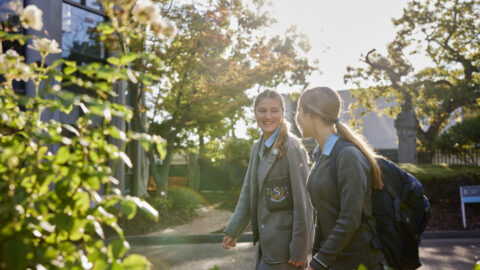Adaptability After Adversity

As a school, we continue to remain vigilant in a post-COVID period regarding the health and wellbeing of all students who may still be impacted by two years of disrupted learning and lockdowns.
Last term, students in both the upper years of Barbreck and the Senior School completed the nationwide Resilience Survey. The Survey gives our School invaluable results to measure the resilience, mental health, and wellbeing of our cohorts. As participants in this national survey over consecutive years, our benchmark data is not only at a national level, but we are also able to track cohorts as they transition through their years of schooling.
From a national perspective, results indicate that Australian adolescents commonly reported positive experiences and used active coping strategies during COVID. Some young people demonstrated higher levels of resilience and were able to make the most out of an unpredictable situation that severely disrupted their daily routine.
However, further prospective research using longitudinal methods is beneficial to examine causal relationships between variables. An implication of the findings is that resilience-building programs for adolescents may be effective in increasing ‘adaptability after adversity,’ such as pandemics.
To date, the focus in St Catherine’s Wellbeing Programs for our younger cohorts is on specifically targeting their development of social skills that were somewhat inhibited through months of not attending school. Understanding the golden rules of friendship, building trusting relationships and managing use of technology remain undercurrents of each Program, with the aim to build a culture of kindness and care for all. For our Years 9 and 10 students the focus draws on prominent educational research that reveals regardless of previous achievement or ability, self-efficacious students work harder, persist longer, persevere in the face of adversity, have greater optimism, and lower anxiety, and achieve more.
For our VCE students, the development of communication and leadership skills, in addition to learning techniques to improve sleep and reduce anxiety, often brought about catastrophising academic pressure are always high on our wellbeing agenda and endorsed every day in teacher-led classroom conversations.
Ultimately, we hope to encourage every girl to step into the opportunity of learning, even when it is initially difficult. Students who are happy, healthy and understand their self-agency are ready to learn.
In addition to this, we teach age-appropriate programs and conversations about the more challenging risk appetites of teenagers today. By way of example, in the coming week, our Senior Years students (Years 10 to 12) will hear from renowned drug and alcohol educator, Mr Paul Dillon.
In light of this, I was pleased to see the proposed changes to non-prescription vapes announced this week by the Federal Government with non-prescription flavoured vapes banned and the amount of nicotine allowed in prescription-only products reduced.
When first introduced, vapes were considered an aid to smoking cessation and to directly assist long-term cigarette smokers quit the habit. Vapes were even viewed in the early days as a harmless habit. Unfortunately, what seems to have transpired is an alarming uptake by Australian teenagers with national data revealing one in every six teenagers aged 14 to 17 has vaped, and one in four people aged 18 to 24 has vaped.
Studies have shown that vaping can damage the lungs and lead to respiratory problems. Nicotine, a key ingredient in many vaping products, can also harm the developing brains of teenagers. In fact, research has linked vaping to decreased cognitive function and increased risk of addiction to other substances.
Moreover, the flavoured e-liquids used in many vaping devices can be particularly appealing to young people, but they can also be harmful. Some of these flavours contain chemicals that can cause irritation, inflammation, and damage to the lungs.
Paul Dillon provides a factual account of vaping in the link below to sort the ‘fact from the fiction’ for parents struggling to understand the impact of vaping.
Paul Dillon Parent Resource: Vaping.
All successful wellbeing programs rely heavily on the partnership between School and home. This begins with a trusting, respectful relationship between parents and teachers. As such, I encourage open communication and support of School Policies and a willingness to take steps together to educate and protect young people, to ensure their good health and happiness.


